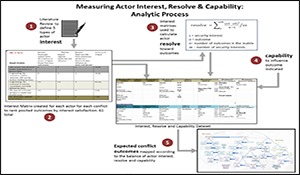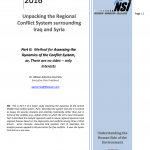Part II: Assessing Dynamics of the Iraqi-Syrian Conflict

Unpacking the Regional Conflict System surrounding Iraq and Syria—Part II: Method for Assessing the Dynamics of the Conflict System, or, There are no sides—only interests.
Author | Editor: Astorino-Coutois, A. (NSI, Inc).
This is Part II of a larger study exploring the dynamics of the central Middle East conflict system. Part I described the system and why it is critical to assess US security interests and activities holistically rather than just in terms of the conflicts (e.g., defeat of ISIL) in which the US is most interested. Part II described the analytic approach used to assess regional dynamics and regional futures based on the alignments and conflicts among three critical drivers: actor interests, resources and resolves. Part III illustrates the analytic process applied to 20-plus actors for five conflicts. It uses the Syrian Civil War as a use case.
In this region in particular, the absence of warfare does not translate either to stability or to peace. As former Chairman of the Joint Chiefs Dempsey suggested in testimony to Congress1, the key question is not how to manage or avoid warfare in the Middle East, but which are the general conditions for peace and stability and what might the US and international community do – or avoid doing – in order to promote those.
What are the dynamics embedded in the region’s current conflicts that will drive it toward one future or another? The outcomes of conflicts are not the result of a single actor’s actions or desires, but are a product of the interactions of opponents; the forces that determine one or another regional future reflect the confluences of actors’ interests, capabilities and resolve. Thus, one way to assess the dynamics that propel the system is to consider three factors that condition the behaviors of state, sub-state and non-state actors:
- Interests — the various security, political, social, economic, and influence interests that an actor perceives to be at stake;
- Capability — the ability to directly influence or cause an outcome to occur; and
- Resolve — the intent or willingness to do so.
The alignment of interests between actors will determine the set of potential outcomes for any particular regional or sub-regional event. However, common interests or alignments between actors may vary across events or conflicts; we cannot assume that a preference for the same outcome in one event will result in shared interests among the same actors in other events. While the alignment of actor interests determines possible outcomes, the distribution of actor resources and resolve across those outcomes governs the likelihood that an outcome will emerge. In other words, the dynamics that determine one or another future reflect the confluences of actors’ interests, resources and resolve.
How stable that outcome is likely to be, however, will be determined not so much by the resources of those who support it, but the resources of those who oppose it. By considering the actors whose interests are blocked or destroyed by a particular outcome, we can also gain insight into the potential durability of a particular outcome. In short, the outcome of a conflict is a function of the interests and preferences of the actors with the greatest resources and resolve relative to that conflict. The durability of that outcome on the other hand, is determined by the resources and resolve of those whose interests remain unfulfilled by the outcome. In shorthand the analytic model is this: Interest + Resolve + Capability = Expectations for the Region.

Comments